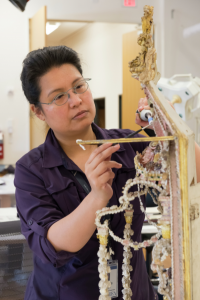
Shelia Payaqui, Conservator
VMFA Photo Resources
What were the most difficult aspects of conservation?
SP: In general, the most difficult aspect of conservation is the amount of time you can dedicate to a particular conservation project. In the ideal world, one would have unlimited time and funding to research and treat an object. But, the reality is that a conservator has a multitude of responsibilities and obligations to other departments, budget constraints and exhibition deadlines.
How did you first tackle this approach to conservation?
SP: First, I prioritize the conservation needs of the sculpture. I look at the stability. For example, is there a part that is about to fall off? I also look at the level of soiling and debris. I asked, “Does the amount of dust and dirt pose a preservation concern?” I also examine the object for any missing elements. Then I determine the curatorial expectations for the treatment. Curatorial expectations may include (but isn’t limited to) what information they want to know about the object (e.g. how it was made); how they believe it should look after treatment; and when they want to put in on display.
Is it finished being restored?
SP: Conservation efforts will continue for this object. I would like to take a more in depth look at the different materials (perform paint analysis, identify the wood, etc.) and test to see if past restoration efforts are reversible.
How does it compare to other pieces that you have worked with (in regards to the cultural differences in technique as a product of its time)?
SP: I’m still trying to figure how to answer this question succinctly.
Was it difficult to conserve the organic aspects?
SP: It was no more or less difficult than working with inorganic materials. As an objects conservator, I am trained to understand the properties of a wide-range of materials and the ways that the materials are utilized in sculpture and decorative arts manufacture.
What was your main goal in conserving this work?
SP: The goals for this conservation campaign were to stabilize the structure (glass enclosure); reduce the accumulation of dirt and debris; document the past restoration efforts; and recreate the missing “glass” pieces behind the Pieta figure.
What methods did you use in conservation?
SP:
- UV fluorescent examination to help locate areas of previous restoration.
- Solvent testing in order to develop a cleaning method.
- Solvent and mechanical (e.g. vacuum attached to a rheostat to control the level of suction) cleaning methods.
- Mold making to create the “glass” replacement pieces.
- Inpainting (conservation technique) to visually integrate areas of losses in the gilded areas (exterior suction) cleaning methods.
Links to Other Pages
Brazilian Oratory: Baroque, Rococo, and Local Influences
Brazilian Oratory: Notes on Brazilian History
Our Lady of Piety Oratory: The Influence of European Religion on South America
Our Lady of Piety Oratory: Condition through the Years
Our Lady of Piety Oratory: Conservation
The Story of How the Beetle got its Colors